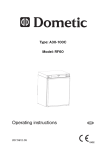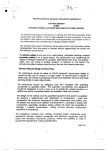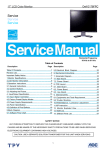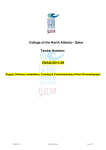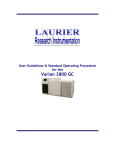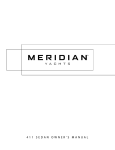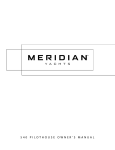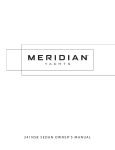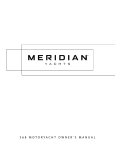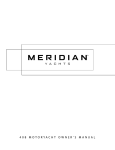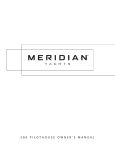Download 520 Gases
Transcript
520 Gases Gas requirements Gases for packed columns The carrier gas you use depends upon the type of detector and the performance requirements. Table 520-1 lists gas recommendations for packed column use. In general, makeup gases are not required with packed columns. Table 520-1 Gas Recommendations for Packed Columns Detector Carrier Gas Comments Detector anode purge or reference gas Electron Capture Nitrogen Maximum sensitivity Nitrogen Argon/ Methane Maximum dynamic range Argon/Methane Nitrogen Maximum sensitivity Hydrogen and air for detector Helium Acceptable alternative Flame Ionization Flame Photometric Hydrogen Hydrogen and air for detector Helium Nitrogen Argon NitrogenPhosphorus Thermal Conductivity Helium Optimum performance Nitrogen Acceptable alternative Helium General use Hydrogen Maximum sensitivity (Note A) Nitrogen Hydrogen detection (Note B) Argon Maximum hydrogen sensitivity (Note B) Hydrogen and air for detector Reference must be same as carrier Note A: Slightly greater sensitivity than helium. Incompatible with some compounds. Note B: For analysis of hydrogen or helium. Greatly reduces sensitivity for other compounds. Jun 2001 Site Preparation Agilent 6890 Gas Chromatograph Service Manual 1 of 14 520 Gases Gas requirements Gases for capillary columns When used with capillary columns, GC detectors require a separate makeup gas for optimum sensitivity. For each detector and carrier gas, there is a preferred choice for makeup gas. Table 520-2 lists gas recommendations for capillary columns. Table 520-2 Gas Recommendations for Capillary Columns Preferred makeup gas Second choice Detector anode purge or reference gas Hydrogen Argon/Methane Nitrogen Helium Argon/Methane Nitrogen Anode purge must be same as makeup Nitrogen Nitrogen Argon/Methane Argon/ Methane Argon/Methane Nitrogen Hydrogen Nitrogen Helium Helium Nitrogen Helium Nitrogen Nitrogen Helium Hydrogen Nitrogen Helium Nitrogen Nitrogen Nitrogen Argon Nitrogen Helium Nitrogen Helium** Nitrogen Nitrogen Helium** Hydrogen* Must be same as carrier and reference gas Must be same as carrier and reference gas Detector Carrier gas Electron Capture Flame Ionization Flame Photometric NitrogenPhosphorus Thermal Conductivity Helium Hydrogen and air for detector Hydrogen and air for detector Hydrogen and air for detector Reference must be same as carrier and makeup Nitrogen 2 of 14 Site Preparation Agilent 6890 Gas Chromatograph Service Manual Jun 2001 Gases Gas requirements 520 * When using hydrogen with a thermal conductivity detector, vent the detector exhaust to a fume hood or a dedicated exhaust to avoid buildup of hydrogen gas. **Helium is not recommended as a makeup gas at flow rate> 5 mL/min Flow rates above 5 mL/min shorten detector life. Jun 2001 Site Preparation Agilent 6890 Gas Chromatograph Service Manual 3 of 14 520 Gases Gas requirements Gas purity Some gas suppliers furnish “instrument” or “chromatographic” purity grades of gas that are specifically intended for chromatographic use. We recommend these grades for use with the GC. Generally, all gas supplies used should be in the 99.995% to 99.9995% purity range. Only very low levels (< 0.5 ppm) of oxygen and total hydrocarbons should be present. Oil-pumped air supplies are not recommended because they may contain large amounts of hydrocarbons. The addition of high-quality moisture and hydrocarbon traps immediately after the main tank pressure regulator is highly recommended. Refer to the next section, The gas plumbing, for more information on using traps. Table 520-3 Gas Purity Recommendations Carrier gases and capillary makeup gases Helium 99.9995% Nitrogen 99.9995% Hydrogen 99.9995% Argon/Methane 99.9995% Detector support gases 4 of 14 Hydrogen 99.9995% Air (dry) Zero-grade or better Site Preparation Agilent 6890 Gas Chromatograph Service Manual Jun 2001 Gases The gas plumbing 520 The gas plumbing WARNING All compressed gas cylinders should be securely fastened to an immovable structure or permanent wall. Compressed gases should be stored and handled in accordance with the relevant safety codes. Gas cylinders should not be located in the path of heated oven exhaust. To avoid possible eye injury, wear eye protection when using compressed gas. Follow the general plumbing diagram when preparing gas supply plumbing. Two-stage regulation On/off valve Main supply on/off valve Moisture trap Hydrocarbon Oxygen trap trap Main gas supply Figure 520-1 General plumbing diagram • Two-stage regulators are strongly recommended to eliminate pressure surges. High-quality, stainless-steel diaphragm-type regulators are especially recommended. Jun 2001 Site Preparation Agilent 6890 Gas Chromatograph Service Manual 5 of 14 520 Gases The gas plumbing • On/off valves mounted on the outlet fitting of the two-stage regulator are not essential but are very useful. Be sure the valves have stainless-steel, packless diaphragms. • FID, FPD, and NPD detectors require a dedicated air supply. Operation may be affected by pressure pulses in air lines shared with other devices. • Flow- and pressure-controlling devices require at least 10 psi (138 kPa) pressure differential across them to operate properly. Source pressures and capacities must be high enough to ensure this. • Auxiliary pressure regulators should be located close to the GC inlet fittings. This insures that the supply pressure is measured at the instrument rather than at the source; pressure at the source may be different if the gas supply lines are long or narrow. Supply tubing for carrier and detector gases Caution Do not use methylene chloride or other halogenated solvent to clean tubing that will be used with an electron capture detector. They will cause elevated baselines and detector noise until they are completely flushed out of the system. Gases should be supplied to the instrument only through preconditioned copper tubing (part no. 5180-4196). Do not use ordinary copper tubing—it contains oils and contaminants. Caution Do not use plastic tubing to supply detector and inlet gases to the GC. It is permeable to oxygen and other contaminants that can damage columns and detectors, and can melt if near hot exhaust or components. The tubing diameter depends upon the distance between the supply gas and the GC and the total flow rate for the particular gas. One-eighth-inch tubing is adequate when the supply line is less than 15 feet (4.6 m) long. Use larger diameter tubing (1/4-inch) for distances greater then 15 feet (4.6 m) or when multiple instruments are connected to the same source. You should also use larger diameter tubing if high demand is anticipated (for example, air for an FID). 6 of 14 Site Preparation Agilent 6890 Gas Chromatograph Service Manual Jun 2001 Gases The gas plumbing 520 Be generous when cutting tubing for local supply lines—a coil of flexible tubing between the supply and the instrument lets you move the GC without moving the gas supply. Take this extra length into account when choosing the tubing diameter. Two-stage pressure regulators To eliminate pressure surges, use a two-stage regulator with each gas tank. Stainless steel, diaphragm-type regulators are recommended. Figure 520-2 Two-stage pressure regulator The type of regulator you use depends upon gas type and supplier. The Chemical Analysis Consumables and Accessories catalog contains information to help you identify the correct regulator, as determined by the Compressed Gas Association (CGA). Agilent Technologies offers pressureregulator kits that contain all the materials needed to install regulators properly. Pressure regulator-gas supply tubing connections The pipe-thread connection between the pressure regulator outlet and the fitting to which you connect the gas tubing must be sealed with Teflon tape. Instrument grade Teflon tape (part no. 0460-1266), from which volatiles have been removed, is recommended for all fittings. Do not use pipe dope to seal the threads; it contains volatile materials that will contaminate the tubing. Jun 2001 Site Preparation Agilent 6890 Gas Chromatograph Service Manual 7 of 14 520 Gases The gas plumbing Traps Using chromatographic-grade gases insures that the gas in your system is pure. However, for optimum sensitivity, it is highly recommended that you install high-quality traps to remove traces of water or other contaminants. After installing a trap, check the gas supply lines for leaks. Table 520-4 Recommended Traps Description Part No. Preconditioned moisture trap: metal casing, s-shaped trap for carrier gas cleanup. Contains Molecular Sieve 5A, 45/60 mesh, and 1/8-inch fittings. 5060-9084 Hydrocarbon trap: metal casing, s-shaped trap filled with 40/60 mesh activated charcoal, and 1/8-inch fittings 5060-9096 Oxygen trap (for carrier and ECD gases): metal casing, and 1/8-inch brass fittings. Oxygen trap cannot be reconditioned. 3150-0414 Moisture in carrier gas damages columns. We recommend a type 5A Molecular Sieve trap after the source regulator and before any other traps. A hydrocarbon trap removes organics from gases. It should be placed after a molecular sieve trap and before an oxygen trap, if they are present. An oxygen trap removes 99% of the oxygen from a gas plus traces of water. It should be last in a series of traps. Because trace amounts of oxygen can damage columns and degrade ECD performance, use an oxygen trap with carrier and ECD gases. Do not use it with FID, FPD, or NPD fuel gases. Oxygen trap Molecular sieve or hydrocarbon trap—both are S-shaped Figure 520-3 8 of 14 Traps Site Preparation Agilent 6890 Gas Chromatograph Service Manual Jun 2001 Gases Cryogenic cooling requirements 520 Cryogenic cooling requirements Cryogenic cooling allows you to cool the oven below ambient temperature. A solenoid valve introduces liquid coolant, either carbon dioxide (CO2) or nitrogen (N2), to cool the oven to the desired temperature. CO2 and N2 require different hardware. You must replace the entire valve assembly if you want to change coolants. The liquid CO2 valve kit is part no. G1565-65510 and the liquid N2 kit is part no. G1566-65517. Choosing a coolant When selecting a coolant, consider these points: • • • • • The lowest temperature you need to reach How frequently you will use cryogenic cooling The availability and price of coolant The size of the tanks in relation to the size of the laboratory Liquid N2 cools reliably to –80°C • Liquid CO2 cools reliably to –40°C CO2 is the choice for infrequent cryogenic cooling because it does not evaporate and is less expensive than N2. However, a tank of CO2 contains much less coolant than a tank of N2 and more CO2 is used for the same amount of cooling. Although liquid N2 evaporates from the tank regardless of frequency of use, N2 tanks contain more coolant than do CO2 tanks and therefore may be better for frequent use. Jun 2001 Site Preparation Agilent 6890 Gas Chromatograph Service Manual 9 of 14 520 Gases Cryogenic cooling requirements Using carbon dioxide WARNING Pressurized liquid CO2 is a hazardous material. If CO2 escapes its container, it exits at high pressure and low temperatures that can be dangerous to personnel. CO2 in high concentrations is toxic to humans. Consult your local supplier for recommended safety precautions and delivery system design. Caution Liquid CO2 should not be used as a coolant for temperatures below –40°C because the expanding liquid may form solid CO2—dry ice—in the GC oven. If dry ice builds up in the oven, it can seriously damage the GC. Liquid CO2 is available in high-pressure tanks containing 50 pounds of liquid. The CO2 should be free of particulate material, oil, and other contaminants. These contaminants could clog the expansion orifice or affect the proper operation of the GC. Additional requirements for the liquid CO2 system include: • The tank must have an internal dip tube or eductor tube to deliver liquid CO2 instead of gas (see Figure 520-4). • The liquid CO2 must be provided to the GC at a pressure of 700 to 1,000 psi at a temperature of 25°C. • Use 1/8-inch diameter heavy-wall stainless steel tubing for supply tubing. The tubing should be between 5 to 50 feet long. • Coil and fasten the ends of the tubing to prevent it from “whipping” if it breaks. • Do not install a pressure regulator on the CO2 tank, as vaporization and cooling would occur in the regulator instead of the oven. • Do not use a padded tank (one to which another gas is added to increase the pressure). 10 of 14 Site Preparation Agilent 6890 Gas Chromatograph Service Manual Jun 2001 Gases Cryogenic cooling requirements 520 Dip tube Correct configuration Figure 520-4 WARNING Incorrect configuration Correct and incorrect liquid CO2 tank configuration Do not use copper tubing or thin-wall stainless steel tubing with liquid CO2. Both harden at stress points and may explode. Jun 2001 Site Preparation Agilent 6890 Gas Chromatograph Service Manual 11 of 14 520 Gases Cryogenic cooling requirements Using liquid nitrogen WARNING Liquid nitrogen is a hazard because of the extremely low temperatures and high pressures that may occur in improperly designed supply systems. Liquid nitrogen can present an asphyxiant hazard if vaporizing nitrogen displaces oxygen in the air. Consult local suppliers for safety precautions and design information. Liquid nitrogen is supplied in insulated Dewar tanks. The correct type for cooling purposes is a low-pressure Dewar equipped with a dip tube—to deliver liquid rather than gas—and a safety relief valve to prevent pressure build-up. The relief valve is set by the supplier at 20 to 25 psi. WARNING If liquid nitrogen is trapped between a closed tank valve and the cryo valve on the GC, tremendous pressure will develop and may cause an explosion. For this reason, keep the delivery valve on the tank open so that the entire system is protected by the pressure relief valve. To move or replace a tank, close the delivery valve and carefully disconnect the line at either end to let residual nitrogen escape. Additional requirements for the liquid N2 system include: • Nitrogen must be provided to the GC as a liquid at 20 to 30 psi. • The supply tubing for liquid N2 must be insulated. Foam tubing used for refrigeration and air-conditioning lines is suitable for insulation. Since pressures are low, insulated copper tubing is adequate. • The liquid nitrogen tank should be close (only 5 to 10 feet) to the GC to insure that liquid, not gas, is supplied to the inlet. 12 of 14 Site Preparation Agilent 6890 Gas Chromatograph Service Manual Jun 2001 Gases Supplying valve actuator air 520 Supplying valve actuator air Some valves use pressurized air for actuation (others are electrically or manually driven). Actuator air must be free of oil, moisture, and particulates. It can be supplied from a dried regulated cylinder, although “house” air supplies or air from a compressor are acceptable. Most valves require 20 to 40 psi of pressure to operate. High-pressure valves may require 65 to 70 psi. Valves require a dedicated air supply. Do not share valve air supplies with detectors. See "Valve Control" in the Agilent 6890 GC Operating Manual/CD-ROM for more valve requirements. Jun 2001 Site Preparation Agilent 6890 Gas Chromatograph Service Manual 13 of 14 520 14 of 14 Gases Supplying valve actuator air Site Preparation Agilent 6890 Gas Chromatograph Service Manual Jun 2001














